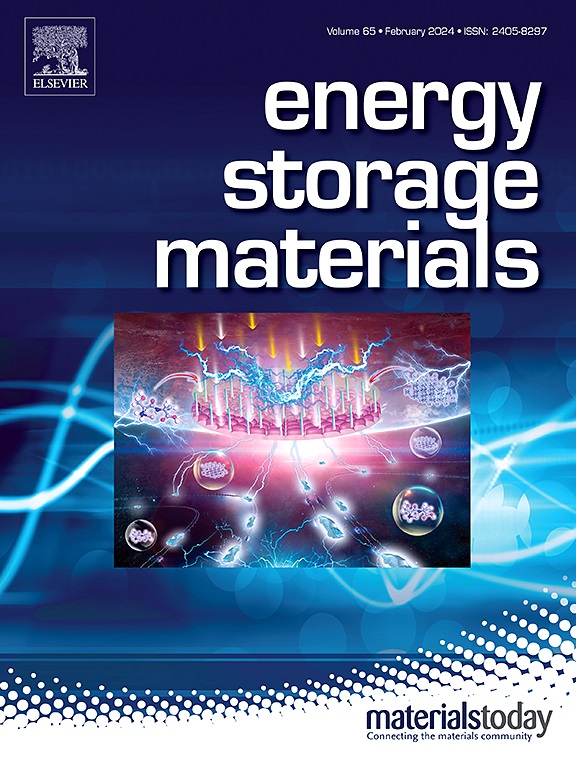Non-destructive and rapid parameter identification of a simplified electrochemical model for lithium-ion batteries via multi-step and physical-informed methods
IF 18.9
1区 材料科学
Q1 CHEMISTRY, PHYSICAL
引用次数: 0
Abstract
Accurate parameter identification of simplified electrochemical models for lithium-ion batteries (LIBs) is crucial for battery management and control. However, existing methods often struggle with parameter coupling, computational efficiency, and physical consistency. This paper presents a non-destructive and rapid parameter identification methodology through an integration of multi-step (MS) and physical-informed (PI) approaches. First, Fisher information matrix-based identifiability analysis reveals parameter coupling relationships, enabling model reconstruction through parameter aggregation. Hierarchical clustering analysis then categorizes parameters into high and low sensitivity groups, establishing the foundation for MS identification. The proposed MS strategy uniquely addresses low-sensitivity parameter challenges through sequential optimization, while the PI method incorporates electrochemical constraints to ensure physically consistent results. An improved particle swarm optimization (IPSO) algorithm also significantly advances population diversity and search capabilities. Numerical validation demonstrates exceptional performance of the proposed identification framework, achieving a 29.73% reduction in mean absolute percentage error of parameters compared to the baseline framework, with most parameters maintaining relative errors below 5%. The proposed IPSO algorithm also has the best convergence characteristics and parameter identification results. Experimental validation under the dynamic stress test condition yields a mean absolute error of 10.12 mV and a root-mean-square error of 14.38 mV, with complete identification requiring only 13.94 seconds. The methodology’s generalizability and practicality are comprehensively validated across diverse operating conditions, external datasets, multiple cathode materials, and even incomplete datasets. The proposed model and method hold considerable promise for extensive applications in adaptive battery control, performance evaluation, and health diagnosis systems.基于多步骤和物理信息方法的锂离子电池简化电化学模型无损快速参数识别
锂离子电池简化电化学模型参数的准确辨识对电池的管理和控制至关重要。然而,现有的方法常常与参数耦合、计算效率和物理一致性作斗争。本文通过多步骤(MS)和物理信息(PI)方法的集成,提出了一种无损和快速的参数识别方法。首先,基于Fisher信息矩阵的可识别性分析揭示了参数耦合关系,通过参数聚合实现模型重构。然后通过层次聚类分析将参数划分为高灵敏度组和低灵敏度组,为MS鉴定奠定基础。所提出的质谱策略通过顺序优化独特地解决了低灵敏度参数挑战,而PI方法结合了电化学约束以确保物理结果的一致性。改进的粒子群优化(IPSO)算法也显著提高了种群多样性和搜索能力。数值验证证明了所提出的识别框架的卓越性能,与基线框架相比,参数的平均绝对百分比误差降低了29.73%,大多数参数的相对误差保持在5%以下。所提出的IPSO算法具有较好的收敛特性和参数辨识效果。在动应力测试条件下的实验验证,平均绝对误差为10.12 mV,均方根误差为14.38 mV,完全识别仅需13.94秒。该方法的通用性和实用性在不同的操作条件、外部数据集、多种阴极材料甚至不完整的数据集中得到了全面验证。所提出的模型和方法在自适应电池控制、性能评估和健康诊断系统中具有广泛的应用前景。
本文章由计算机程序翻译,如有差异,请以英文原文为准。
求助全文
约1分钟内获得全文
求助全文
来源期刊

Energy Storage Materials
Materials Science-General Materials Science
CiteScore
33.00
自引率
5.90%
发文量
652
审稿时长
27 days
期刊介绍:
Energy Storage Materials is a global interdisciplinary journal dedicated to sharing scientific and technological advancements in materials and devices for advanced energy storage and related energy conversion, such as in metal-O2 batteries. The journal features comprehensive research articles, including full papers and short communications, as well as authoritative feature articles and reviews by leading experts in the field.
Energy Storage Materials covers a wide range of topics, including the synthesis, fabrication, structure, properties, performance, and technological applications of energy storage materials. Additionally, the journal explores strategies, policies, and developments in the field of energy storage materials and devices for sustainable energy.
Published papers are selected based on their scientific and technological significance, their ability to provide valuable new knowledge, and their relevance to the international research community.
 求助内容:
求助内容: 应助结果提醒方式:
应助结果提醒方式:


